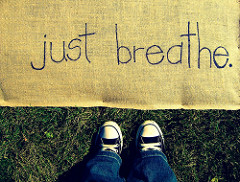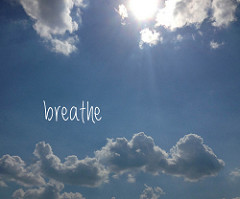 You’re tense and exhausted. Your back aches and you’re irritable.
You’re tense and exhausted. Your back aches and you’re irritable.
You decide that mediation could help.
But with your tight shoulders and racing mind, you can’t settle down. You can’t focus.
So you do what everyone says to do when you need to relax—you take a deep breath.
You inhale as deeply as you can, lifting your shoulders to your ears and letting out your breath with a large huff.
And then…
You don’t feel more relaxed.
Honestly, how many times has taking a deep breath helped you relax?
What happens when you breathe?
 The idea of using the breath to relax is not crazy. There are sound, physiological ways that the breath can reset your nervous system.
The idea of using the breath to relax is not crazy. There are sound, physiological ways that the breath can reset your nervous system.
But unfortunately, not every breath is equal. Some ways of relaxing with the breath are more effective than others.
To understand the relationship between breathing and relaxation, you first need to understand a little anatomy.
An inhalation is created when you expand your lungs. The extra space in the lungs allows air to flow inward. If the lungs are contracted, the air is forced out, causing an exhalation.
There are two mechanisms you use to expand or contract your lungs—your diaphragm and your rib cage.
The diaphragm is a thin muscle that separates the abdominal cavity from the upper trunk. With a relaxed, natural inhalation, your diaphragm contracts and moves downward toward your abdominal organs. This creates space in your upper trunk to allow air to flow into your lungs.
You exhale in reverse. Your diaphragm stops contracting and moves upward. This forces the air out of your lungs.
And your rib cage? Your ribs expand and contract calmly in sync with your diaphragm.
This soft contraction and relaxation of the diaphragm, the gentle up and down movement, happens automatically when you are relaxed and happy.
However, when you are stressed, tense, and nervous, the process changes—dramatically.
Depending on the type and degree of stress, several things can happen to the action of your diaphragm. As your diaphragm tenses, the rate and depth of your breathing can change. Sometimes your diaphragm freezes and hardly moves. And at other times, your diaphragm can actually reverse—moving upward on the inhale and downward on the exhale.
In any of these cases, the diaphragm is no longer functioning optimally to bring air into the lungs. As a result, your ribs need to compensate. Your neck and shoulders start to work double-time to lift your ribs and expand your trunk so that air can flow into your lungs.
These breathing patterns are very strenuous and you end up caught in a loop. You are stressed so your breath gets agitated and your diaphragm doesn’t work optimally. And because your diaphragm is tense and your breathing strenuous, your stress level increases.
This loop—your brain sending signals to your diaphragm to go on high alert and your diaphragm sending signals back to the brain that there is reason for alarm—can build on itself.
The trick to relaxing with the breath is to interrupt this feedback loop.
Your body knows how to breathe
 Knowing how to use the breath to relax is a great tool to reset your nervous system but it’s important to use this knowledge correctly.
Knowing how to use the breath to relax is a great tool to reset your nervous system but it’s important to use this knowledge correctly.
The first principle to remember is that your body knows how to breathe.
This seems obvious. Of course we know how to breathe.
But when you are experimenting with the effects of breath, it’s easy to start to think that one type of breath is better than another. That you should always breathe with your diaphragm. Or that deep, slow breathing is always better than fast, shallow breathing.
Your body has a large repertoire of breathing strategies because you need them. It’s a good thing that your breath changes as the demands of your life change.
So the first principle is that the way you are breathing, however you are breathing, is perfectly fine.
Using the breath to relax is just a tool to interrupt the cycle of stress.
How to use the breath to relax
In a natural, calm breath, the diaphragm is most relaxed at the end of the exhale. The key to using the breath for relaxation is to take advantage of that moment.
As you breathe, allow a full, soft, complete exhale. A soft diaphragm breaks the stress feedback-loop. It resets your nervous system and tells the brain, “Calm down. Everything is fine here.”
Start your meditation with this 6-step breathing exercise:
- Find a comfortable seated position. You can sit on a chair, the floor, or a mat—it doesn’t matter.
- Begin with grounding. Become aware of the floor or chair beneath your body. Feel the contact. Become aware of the back of your body. Sit for a few moments being aware of how grounded you feel.
- Relax your jaw. Bring your attention to your jaw, palette, and back your throat—all the way back to the back your head—and allow that area to relax. There’s no need to force it. Simply invite your muscles to relax. Sit for a moment in relaxation.
- Become aware of your exhalation. Allow a full, complete, soft exhalation. You don’t need to slow it, extend it, hold it, or alter it in any way. Depending on the state of your body, your breathing may be fast or slow, deep or shallow. Your breath is perfectly fine however it is. So instead of changing your breath, become aware of whether your exhalation is complete before the next inhalation begins. Sit with natural breathing for a few moments.
- Rest at the end of the exhalation. Notice that moment that naturally happens between breaths. Take a little break in that moment. You don’t need to extend it—just enjoy it as it comes.
- Continue breathing naturally and softly.
If you don’t have much time, this mini breath-meditation can be done in just a few minutes. And you may be surprised by how good you feel by simply allowing a natural exhalation.
But if you have time, this routine is a great way to begin meditation. Bringing awareness to your exhalation helps quiet your mind. You become present in your body. You live in the present moment.
Taking a deep breath rarely results in relaxation. Deep inhalations contract the diaphragm and could send signals to the brain that there is something to be stressed about.
Instead, allow a full, soft, natural exhalation. Yes, it’s less flashy. But exhaling completely is much more likely to reset your nervous system.
So when you want to focus and slow down, allow a soft, complete exhalation. You’ll probably feel better letting it all out.



Thank you for sharing these great tips and resources. As a regular mediator and a yoga and meditation teacher new tips and techniques are always valuable in expanding my personal practice and then sharing that gift with others. My sincere gratitude to you for sharing.
Hi Elaine,
I’m so glad these tips help. Keep us posted if you notice anything new with your meditations.
Julia
Excellent read. I have asthma and need to pay attention to my breathing before my rib cartilages get inflamed and cause me undue pain and anxiety. Please do send me materials on breathing when possible.
Hi Sidesh,
Great insight to use this technique with asthma. It makes a lot of sense that relaxing the diaphragm by focusing on the exhale would help not only your asthma, but also your rib inflammation.
I would recommend practicing this technique before you have an asthma attack. Once it’s hard to get a breath, it can be even harder to focus on your exhale. It seems slightly counter-intuitive. But if you can relax during an attack, it’s bound to be helpful.
I don’t have any materials on breathing yet. However, if you click on the “breathing relaxation techniques” tag at the end of the post, you will find some articles about the breath.
Also, sign up TaraTrue.com. I love working with the breath. If I write any blogs or courses on breathing, you’ll be sure to get the news.
Practicing regular, mindful breathing can be calming and energizing and can even help with anxiety related health issues ranging from panic attacks to digestive disorders.
So true, Lama Surya Das. Good advice. Thank you.
What a great article on mindful breathing! And it is so amazingly simple! Thank you, Morgan
You’re welcome. Let me know how it works for you.
Love your blog! Great information. Let’s spread the word and bring peace to our world!
What a great New Year intention! Thank you.
Hi there. What a useful article. I currently have pneumonia with a consolidation in the lower part of my right lung. Do you have any particular recommendations for a healing breath? Many thanks
Hi Anne,
I’m so sorry to hear about your pneumonia, Have you been to a doctor? If not, your first healing breath should be one that takes you to a doctor’s office! Follow their recommendations and hopefully, you will be on your feet soon.
Once you are well enough to sit without coughing, you can start working with your breath. Since one of your lungs is affected more than the other, you might notice imbalance in your breathing from right to left. If so, I recommend that you work with that.
Lie on your back with your knees bent and your feet flat on the floor. Take a moment to relax and bring your awareness to your body. Feel the floor beneath you.
When you feel grounded and calm, draw your attention to your breathing. In particular, become aware of how the breath feels left to right. You may notice that one side feels different from the other. At first, don’t try to change the imbalance–simply notice. Sometimes just the act of bringing awareness to the imbalance can begin to correct it. Stay in awareness for a minute or two.
If you notice that one side feels more restricted or congested than the other, imagine that side open and relaxed. Since your lungs are healing, you don’t need to force air into one side or try to expand it. Simply invite that side to soften. This is a gentle invitation–kind. Soft. Loving. Your lungs have been doing a lot of work so no need to stress them.
Your mind is very powerful. Just bringing awareness and an invitation to open may help your lungs to re-balance.
Good luck. I hope you feel better soon.
Thank you so much for your helpful response. I will start to implement this technique straight away. I have been under my doctor’s care the whole time and am now waiting for a MRI. Many thanks X